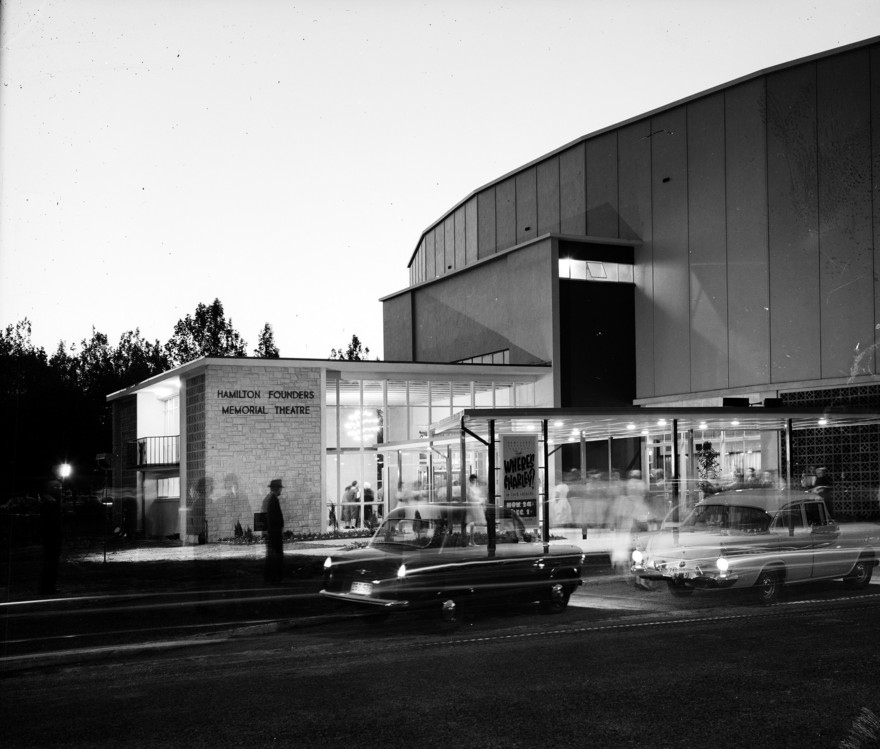
Ford Motors' finest attend the opening night of the Founders Memorial Theatre, Hamilton, November 1962
The appearance of New York’s rock and roll animal Lou Reed at Hamilton’s Founders Theatre in 1977 was one out of the box, even if – by necessity – sizeable provincial venues must offer a wide range of performers and sounds.
The first concert of Reed’s 1977 Australasian tour was a Tuesday night slot at the Founders, where $8.20 got you a seat for the 8.30pm 1ZH-promoted show on 18 October. Reed had visited New Zealand before, in 1974 and 1975, where his albums would consistently enter the Top 20.
Sue O’Dowd reviewed the concert for the Waikato Times, noting that “the godfather of punk rock” opened with ‘Sweet Jane’ and duly pulled the aroused punters quickly to their feet. When hall management insisted they remained seated, a grumpy Reed suggested a ballad while they “jerked off.” That would have been the least of the vices a Lou Reed audience indulged in. By then punk rock had arrived to bolster the glam and smack acolytes who peopled Reed’s early to mid-1970s crowd.
This was probably not the right crowd for the support act, Dunedin piano-playing chanteuse Lea Maalfrid; O’Dowd reported relief on the part of the audience when she finished. Reed would have been in better company in 1978, when Richard O’Brien’s Rocky Horror Show squeezed in two late August dates on the production’s first national tour.
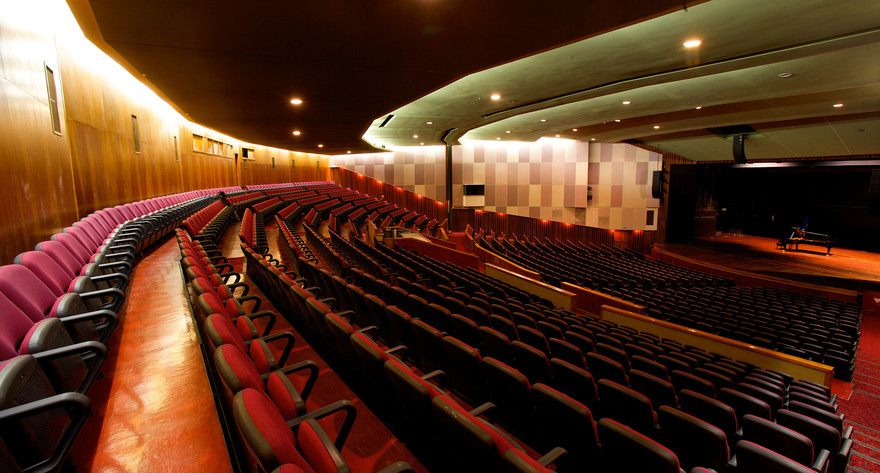
Founders Theatre, interior during the 2000s
Earlier in 1977, in June, the Founders hosted British R&B belter Joe Cocker, whose most recent New Zealand hit single was ‘You Are So Beautiful’ in 1975. In his band were saxophonist Bobby Keys and pianist Nicky Hopkins, regular members of the Rolling Stones’ touring party in the early 1970s; Lea Maalfrid was once again the support act.
Since its opening on 17 November 1962, the Founders Memorial Theatre has seen some of New Zealand and the Western world’s best pop, folk, country and jazz performers grace its wide, modern stage. The 1249-seat theatre – built for over £250,000 – sits in Boyes Park on the western edge of the city’s CBD. Designed by Hamilton architects White, De Lisle and Jenkins, it was inspired by Coventry’s Belgrade Theatre, the first civic theatre built in Great Britain after World War II.
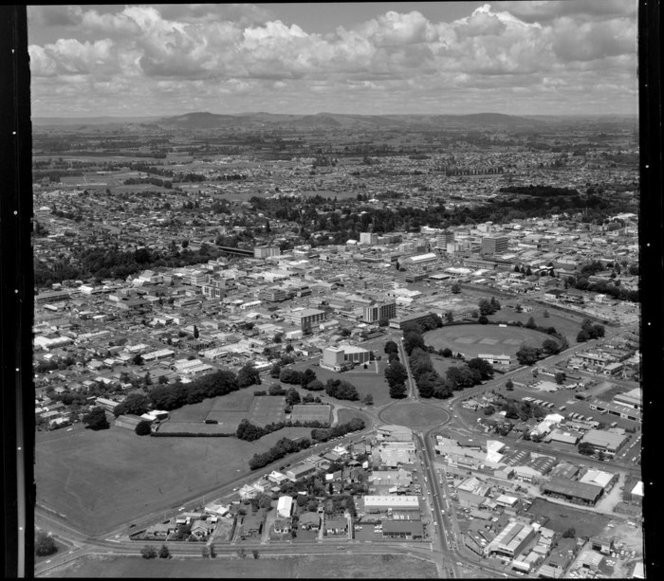
The Founders Theatre is in the centre of this aerial shot of Hamilton, 6 December 1972. Alexander Turnbull Library, Wellington, WA-70912-F - Whites Aviation
International performers of note were soon joined local theatre and music productions in the Founders gently sloping wood panelled confines. Jazz great Louis Armstrong arrived for shows on 20 March 1963, an occasion recounted nearly 50 years later by Waikato Times columnist Richard Swainson in ‘A Night To Remember.’
“A large crowd had gathered outside the Founders to take part in a welcoming event organised by radio station 1XH,” wrote Swainson. “As many as 300 people waited to catch a glimpse of Armstrong on the Founders balcony, where a local five-piece jazz band had set up and begun to play. There was an expectation from some that Satchmo might jam with the Hamiltonians.
“As it turned out, the crowd was lucky Armstrong appeared at all. [Ira] Mangel who saw himself as a representative of Armstrong’s manager, Joe Glaser, was determined not to let the star client appear before any audience without adequate remuneration.”
Finances sorted, the first of the night’s two shows proceeded. “The contemporary Times review was a predictable rave, balancing an appreciation of Armstrong and his reputation against the contributions of [support act] the Cano Quartet, vocalist Jewel Brown and other All Stars members. Facing a possible expulsion from the tour for his alcoholic indulgence, [bassist Art] Shaw was particularly impressive in his bass guitar solo ‘How High the Moon’.”
“Man, did he play that night,” local radio personality Laurie Borck recounted to Swainson.
Jazz would be a continuing presence at Founders Theatre. British jazzers Kenny Ball and Acker Bilk played there on 25 February 1965. Only five months earlier, on 15 September 1964, Bilk had performed at Hamilton’s Embassy Theatre on Victoria Street, a venue the Founders had largely supplanted. (On the night before Bilk’s 1964 appearance in Hamilton, classical guitarist Andres Segovia demonstrated his nimble-fingered magic at the Founders.)
EQUALLY As monumental as LOUIS Armstrong’s visit was jazz pianist Thelonious Monk at the theatre in 1965.
As monumental as Armstrong’s visit was, almost as legendary was the performance unorthodox African American jazz pianist Thelonious Monk at the theatre on 6 June 1965. Five days later, hit Danish-Dutch folk duo Nina and Frederick performed there. They returned again in September 1968.
Traditional folk music and the folk revival was another important strand threading through the Founders’ music history in the 1960s. Chas McDevitt and the All-British Folk Spectacular were featured on 6 March 1966 and, on 12 April, the New Christy Minstrels.
Earlier in the 1960s, with pop on the brink of generational change, there were still ample audiences for African-American entertainer Elroy Peace on 9 July 1963, billed with The Sheratons and Jimmie Sloggett. Peace found time during his New Zealand visit to record two of his own songs (‘Don’t Forget The Stars’ b/w ‘You Got It Made’), with Sloggett producing, for Wellington label Viking Records.
The next show at the Founders was the Royal Variety Tour with Howard Morrison, Bill & Boyd and Max Merritt and The Meteors. It wasn’t unusual to get a mix of sound and style on bills in this era, as The Gigantic Jimmie Rodgers Show with Terry Stafford, Dinah Lee, Lou & Simon and American female singing stars The Crystals demonstrated at the theatre on 15 October 1964. Morrison was soon back with the Showtime Spectacular ’64 on November 7.
More surprising was the run of package shows from the United States and Great Britain that shook the Founders’ walls in the 1960s. With the teen population of Hamilton and the Waikato bursting, there was a large and appreciative audience ready and available to see the likes of The Beach Boys, The Surfaris, and Roy Orbison.
On 8 June 1965 The Dave Clark Five, supported by Tommy Quickly, Ray Columbus and The Invaders, The Pleasers and Lew Pryme, wowed the teen masses. Sitting in the audience, with his mother Mary and older sister Carolyn, was 12-year-old Tim Finn, then known as Brian. It’s a venue Finn would get to know well in the 1970s and beyond as a performer. Speaking to Chris Bourke in 1993, he described the Dave Clark Five concert as an “epiphany”. When Clark, sitting behind the drum kit, began playing, “My sister started screaming and ran down the front, and I realised that this music had a – I wouldn’t have known how to put it then – but it had a sexual element to it. Up till then they’d just been tunes, and being haunted by melodies, That’s when I became obsessed, and got into the romance of groups.”

British music corporation: Cilla Black, Freddie and the Dreamers, Sounds Unlimited and Mark Wynter at the Founders, 1965. The local support act was Herma Keil and the Keil Isles – Htown Wiki collection
“My sister started scrEaming and ran down the front” – TIM FINN AT THE DAVE CLARK FIVE, 1965
Manfred Mann, The Kinks and The Honeycombs knocked out their fresh R&B hits at the Founders on 2 February 1965. Two weeks later came US soloist Gene Pitney, Jamaican teenage ska sensation Millie Small, as well as local support acts Peter Posa, Barbara English and Nick Villard.
Continuing the flow of British beat era acts that year, the following month saw Cilla Black, Freddie and The Dreamers, Sounds Unlimited and Mark Wynter, take the stage, supported by frequent Waikato visitors Herma Keil and Keil Isles. They were all a few generations removed from Gracie Fields – a UK star during World War II – who appeared at the Founders a few days later.
The next overseas package tour to visit Hamilton was the notorious Sandy Shaw’s Shindig, on 19 August 1965. While the barefooted Shaw was top of the bill, next in line was perhaps the wildest British hit R&B group yet, The Pretty Things. Further down were British pop star Eden Kane, and locals Tommy Adderley, The Chicks and radio DJ Cham The Man.

Tommy Adderley was among the local support acts when Manfred Mann and The Kinks played the Founders, Hamilton, in 1965 – Htown Wiki collection
Two weeks earlier, New Zealand showed confidence in its own beat-era stars, with the Best of Beatside bringing a collection of acts to the Founders that included Gary Reilly, Tommy Adderley, Four Fours, Lew Pryme, Sandy Edmonds and Mike Perjanik, who had all featured on the TV show of the same name.
The Hamilton Pop Festival on 2 September 1965, managed to push three prominent Fountain City groups, The Mods, The Trends and The Paragons onto stage with Tommy Adderley and Sandy Edmonds. Six days later, The Merseybeat had the Brian Epstein-managed Billy J. Kramer and The Dakotas and huge Australian act, Billy Thorpe and The Aztecs at The Founders with fellow Australians The Cicadas, and Wellington’s The Librettos and Jim McNaught.
Rounding out a big month, Dinah Lee, The Chicks, Tommy Adderley and Nick Villard, combined with New Zealand-resident Australians The Defenders (who recorded as Hubb Kapp and The Wheels), Lonnie Lee and The Rajahs performed at The Founders on 21 September 1965.
Millie Small would return on 10 March 1966 (the poster said “Bang! the firecracker voice explodes on stage”) with fellow ska star Jackie Edwards, the Jamaican composer of Spencer Davis Group’s hit ‘Keep On Running’. Also on the bill were Dinah Lee, Kerry & Allan and Tommy Adderley.

Herma Keil and the Keil Isles, plus Bill & Boyd, support The Seekers at the Founders, Hamilton, 1966 – Htown Wiki collection
In November 1966, 500 Waikato teens flocked to the Founders Theatre to hear Derek Lowe, one of the directors of pirate radio station, Radio Hauraki, put his case. When the rebels finally put to sea on the Hauraki Gulf, their signal could be clearly heard in the region.
Maria Dallas – one of the Waikato region’s biggest stars – brought her family-friendly show to the theatre on 9 December 1966, appearing with Jay Epae – the writer of her big hit, ‘Tumblin’ Down’ – and C&W acts Ken Lemon and Garner Wayne in support.
for teenager terence Hogan the sight of Jimmy Page of the Yardbirds scraping a cello bow across the strings of his Telecaster was unforgettable
Before the British invasion tap was turned off, there would be one more package tour of note at the Founders. On 1 February 1967 an incredible bill came to the Founders, the last of The Big Show-bannered tours. It featured The Yardbirds, Roy Orbison, The Walker Brothers, Mr Lee Grant, Larry’s Rebels and Sandy Edmonds. Among those present was teenager Terence Hogan, who in the 1970s would become a graphic artist and employee of WEA Records. He also experienced an epiphany at the Founders. Most of the audience had come to see Orbison and The Walker Brothers, but to Hogan the sight of Jimmy Page of the Yardbirds scraping a cello bow across the strings of his Telecaster was unforgettable, as he writes on his website:
“Polite clapping followed each number and at one point [Yardbirds singer] Keith Relf went to the microphone and said, ‘You’re a quiet lot, aren’t ya?’. The atmosphere was a bit like their gig in Antonioni’s Blow-Up before the riot broke out, but I was still thrilled to be there. I liked the Walker Brothers’ hits at their most Spectorean so I was happy to hear ‘The Sun Ain’t Gonna Shine Anymore’, and of course Roy’s bill-topping melodrama outdid even theirs. But it was the Yardbirds that I had really gone to see and their fascinating but puzzling set caught me off-guard a little, and in retrospect was just what I needed. I’m sure I left the theatre doubly eager for the life that I hoped would soon come; the one in which I regularly acquired records of all kinds and heard live music that stretched my tastes and opened me up. I sensed that being challenged by music was as important as increasing my enjoyment and knowledge of music I was already engaged with.”
Another Hamiltonian, Craig Otto, describes that concert as the best he ever saw: “Larry’s Rebels destroyed Jimmy Page and the Yardbirds and then after the interval Roy Orbison came out and destroyed the whole theatre. He never moved and by the end we were going apeshit bananas.” (Otto would make his own debut on the Founders’ stage in 1979, playing a priest in Hamilton Operatic's production of Jesus Christ Superstar. “We were lowered onto the stage from 60ft above the stage. There was no question about stage fright. I was so glad to still be alive when we got to the stage I didn't care who was watching.”) On the Facebook page Memories of Hamilton Music, Ken McNeil recalled that Larry’s Rebels’ set-list tried to please everybody: “When they did ‘Inside Looking Out’ – a 1966 hit for The Animals – a ‘pre-British Beat Boom’ guy in front of me became really agitated about the 'rubbish’ they were playing. Their next number was ‘Green Green Grass of Home’, and the guy went into raptures.”
After 1967’s Big Show things seemed to settle down a bit at the Founders until July the following year, when the Blast Off ’68 show featured Larry’s Rebels, popular Australian solo act Johnny Farnham, Ray Woolf, Gene Pierson and Hi-Revving Tongues. Decimal currency had arrived, and the 8pm show cost $1.05 or $1.55; the promoters were Benny Levin and Russell Clark.
Mostly, though, the 1968 offerings were family orientated fare such as The Seekers (who had visited in 1966), Shirley Bassey supported by Bill and Boyd, Nelson-born country star Tex Morton, and Maria Dallas backed by Hamilton’s The Satellites. Also that year, Hamilton’s “First Jazz Festival” saw 150 musicians swarm the Founders’ stage, the 1968 C&W Stage Show, and The Seekers’ Judith Durham performing solo.
By the 1970s the Founders was well established on the touring circuit as a venue for overseas acts (Fairport Convention, Donovan and Glen Campbell appearing in 1975 alone) and locals with records in the charts.

A 1975 publicity shot of Split Enz, taken in the Auckland Domain. L to R: Noel Crombie, Tim Finn, Phil Judd, Eddie Rayner, Mike Chunn, Paul Crowther, Wally Wilkinson.
Split Enz enjoyed a long association with the Founders Theatre, with a gig in late 1974 having special significance. Top of the bill was Space Waltz (featuring Tony aka Eddie Rayner as guest keyboardist), whose No.1 hit ‘Out On the Street’ ensured a full house. But for the Enz, this was the night Geoffrey (Noel) Crombie – having just been anointed a full member of the group – arrived at the backstage dressing room bearing gifts. In Stranger than Fiction, Mike Chunn recalled: “Mr Crombie walked in with a bulky suit-carrier and pulled from it a selection of brightly coloured suits. For the first time we looked upon a set of Crombie original costumes designed and sewn by the man himself. In wild, pastel colours, distorted shapes and angels, the suits stood before us as a symbol of the new era ….
“This night we had everything right … in a wild, tight show that featured the beautiful, uplifting ‘Instrumental’ for the first time. Geoffrey was on stage for the entire performance, banging his tambourine while standing stiffly beside Phil. It was his first chance to contribute in full, all the while waiting for the big moment – the spoons solo. And when it came, he played as if he was born with spoons in his hands. As the crowd roared, we knew that his entry into our ranks had been an auspicious decision. In the new costumes we moved our stage presentation a few more steps outside the boundaries.”
Hello Sailor and Golden Harvest were local acts that appeared at the Founders when their hit singles and albums meant they needed larger venues than the Hamilton Hotel, Te Rapa Tavern and Hillcrest Tavern. On 15 April 1978, with ‘Lying In The Sand’ in the Top 30, Hello Sailor stepped on to the city’s big stage during a New Zealand Student Arts Council tour to promote their first album. Tickets were $3 for students, $4 for the general public.
Dunedin’s Mother Goose played the Founders Theatre, Hamilton, on 20 November 1977. Alexander Turnbull Library, Wellington, Eph-C-MUSIC-Popular-1977-02
Golden Harvest – who, like many of the best New Zealand pop acts of the 1970s had strong Waikato roots – appeared at the Founders on 9 May 1978, in the wake of their irresistible pop hit, ‘I Need Your Love’. Its follow-up, ‘Give Me A Little Love’, was still in the charts. Shortly afterwards the stage welcomed Citizen Band, promoted by Radio Waikato; then Rob Guest, supported by Tina Cross.
Evidence of the wider Waikato region’s wider role as the hub of mass music festivals in the late 1970s and early 1980s, came in the form of Nambassa’s Winter Show on 14 October 1978. On the bill were Mahana, Rick Steele and the Nambassa Theatre Troupe.
On 13 March 1979 Jon Stevens shared the stage with Sharon O’Neill; nine months later he would hit No.1 with both ‘Jezebel’ and ‘Montego Bay’, and then the pair would have a reach No.5 with their duet ‘Don’t Let Love Go’. This success required a return appearance at the Founders.
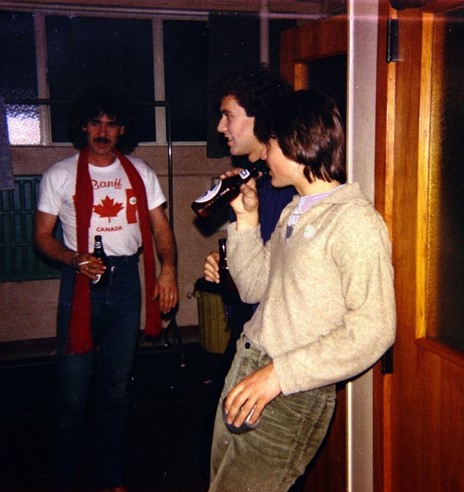
Th' Dudes singer Peter Urlich (centre) backstage at the Founders Theatre with the band's roadies Keith McKenzie (left) and Richard Morris, 1979
Split Enz already knew the road home well or least the Finn brothers did, when they arrived on the rebound from Australia and England to promote Frenzy, just as the album peaked at No.3 in April 1979. Dragon – yet another of the Waikato’s finest pop products, albeit with a darker edge – blew into town on September 23, 1979.
Mopping up the best of the rest of those furious pop years was Mi-Sex’s Space Race Invasion, with The Swingers in support, on 20 June 1980. Overseas acts at the Founders in 1980 included Leo Sayer, US soul act The Sylvers (whose ‘Boogie Fever’ hit No.4), African-American C&W singer Charlie Pride, Tex-Mex star Freddy Fender, and the heavy-lidded Australian actor and singer Jon English.

Rob Guest appears in Joseph and the Amazing Technicolour Dreamcoat, late 1970s. Alexander Turnbull Library, Wellington, Eph-D-OPERA-1970s-02
Perhaps the most unusual and surprising act to play the Founders Theatre during this period of rapid pop flux was doomy English post-punkers The Cure. In July 1980 Robert Smith’s group was in New Zealand on the back of the success of their first three albums and the brilliant single ‘A Forest.’ In the Waikato Times, Grant Hubbard found the English group “strange but superb” and – despite tickets being only $8 – he noted the theatre was only half full, the audience being mainly teenagers.
It’s a lesson that Liverpool’s Echo and The Bunnymen would heed. The neo-psychedelic quartet was on the rise, with their album Heaven Up Here in the New Zealand Top 20. But when ticket sales didn’t reach the needed level for their 7 November 1981 show at the Founders, the gig was shifted to Macey’s, a suburban rock club just off the Cambridge Road in an industrial area in Hamilton’s southern reaches.
Split Enz was in well into its golden era when the group came to town to promote hit album Waiata on 28 April 1981. Four months later, reggae made its debut on the Founders stage, when British act Black Slate brought their Amigos album live to Hamilton on 10 August, a Monday night. It was Business As Usual for Australia’s world-wide hitmakers’ Men At Work, who crammed them in at the Founders on 8 May 1982. Other overseas acts appearing during the 1980s included George Thorogood and the Destroyers, Iva Davies’ Icehouse, The Hoodoo Gurus and OMD (Orchestral Manoeuvres in The Dark); tickets for the latter were $25.40.
THE Founders Theatre would be an important part of the Waikato’s musical culture and its economic structure for over 50 years
Having witnessed 20 years of change in popular music, the Founders Theatre would remain an important part of the Waikato’s musical culture and its attendant economic structure for the next 35 years. Visting included aging British and American acts from the 1960s and 1970s, such as The Hollies (March 1983), Uriah Heep (April 1984), The Commodores (June 1984 and November 1985), The Shadows (February 1985), Village People (August 1994), Boney M (February 1996) and Joe Cocker yet again (March 1996). Later still, tribute shows to early era’s stars would become a regular feature.
New Zealand’s biggest acts continued to play the Waikato’s biggest city. Sharon O’Neill ended her September 1983 tour at the Founders. Christchurch’s Dance Exponents – having just returned from Australia – visited on the back of their aptly named Sex and Agriculture LP in September 1984, returning eight months later to push Expectations.
Split Enz ended its first burst of life with their Enz With A Bang farewell tour in December 1984, which included two nights at the Founders. Six months later, Tim Finn was back as a solo act. Not to be outdone, brother Neil’s Crowded House blew into town on 7 June 1987, just a few weeks after ‘Don’t Dream It’s Over’ reached No.2 in the US charts. They returned in April 1992, shortly after Tim’s stint with the band came to an end; the tour was named, “Then There Were Three”. The Finn Brothers would return to the Founders as a duo on 8 March 1996, the final date of their An Evening with Neil and Tim tour.

The Finn Brothers, close to their home town at the Founders Theatre, Hamilton, March 1996
The Waikato’s own groups could still be found at the Tristram Street theatre in the 1990s and beyond. In early October 1993, the Rock93FM Waikato Rock awards, hosted by George Smilovici, presented three finalists in the rock section: Swamp Goblin, Pilgrims and Inchworm. Tim Armstrong, Blackjack, 8Forty8, Jacquie Davey and Death of A Monkey won awards, with Inchworm receiving a $15,000 recording contract with Hark Records and a $5000 NZ On Air grant.
College-age groups appeared at the Founders for the Waikato regional finals of the Smokefree Rockquest from the mid-1990s on. From 2006 the National Country Music Awards took place at the Founders.
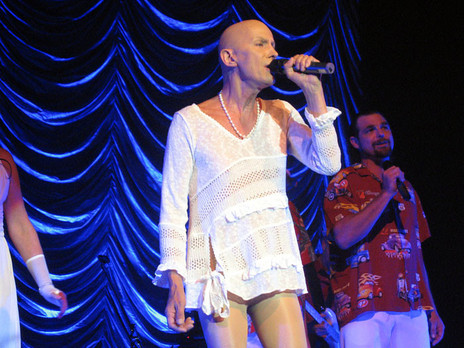
Richard O'Brien performing at Founders Theatre, Hamilton in a fundraiser for Starship Hospital, 2012 - Photo by Grant Stantiall
However on 1 March 1 2016, Hamilton’s venerable cultural heart was closed due to structural concerns. Its future is now in doubt; although there is strong local feeling for its retention or replacement, demolition is a real possibility. Acts to appear in the immediate years before the closure included The Topp Twins, Judith Durham, Fly My Pretties, Dr Hook’s Dennis Locorriere, Richard O’Brien’s It’s My Party, a That’s Country reunion show, John Rowles, Bonnie Raitt, Dragon, Hammond Gamble, Hello Sailor, Brooke Fraser, The Irish Rovers, Foster and Allen, Flight of The Conchords, Six60, Graham Gouldman’s version of 10cc, and The Pink Floyd Experience.

Mark Williams with Dragon at the Founders Theatre in Hamilton, 2007 - Photo by Grant Stantiall
Local music fans would share the sentiment of Raglan musician Sid Limbert, who told AudioCulture in 2017, “I have some very memorable moments in that theatre, going back to the Kinks and Manfred Mann. I met the Beach Boys, Gene Pitney, Roy Orbison, etc. From about 1964 I’ve geen going to and playing lots of gigs there. The last gig I went to was the Count Basie Orchestra. I can’t believe they want to blow it up or something, it’s been a great theatre.”
It remains to be seen whether the region’s music fans will once again file past Ralph Hotere’s fine 10x3 metre mural lining the venue foyer’s western wall, as they did from August 1973, when it was first unveiled.
